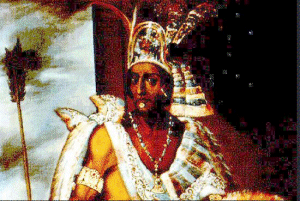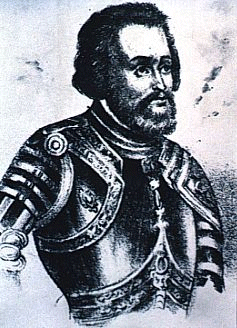|
The Aztec people dominated central and southern Mexico from the 14th to the 16th century and are best known for having established an elaborate and wide-ranging empire destroyed by Spanish invaders led by Hernán Cortéz. The leader of the Aztecs during the Spanish conquest was the Great Montezuma II. Their name is derived from a mythical homeland to the north called Azatlán, but they also called themselves the Mexica. The Aztec language belongs to the Nahuatlan branch of the Uto-Aztecan family. Human and animal sacrifices were an integral part of Aztec religion. For warriors, the ultimate honor was to be slain in battle or to volunteer for sacrifice in a major ritual. The Aztecs are credited with the discovery of chocolate, made from the fruit of the cacao tree. The Aztec and Toltec Early Mexico ~1200 AD - ~1550 AD The Aztecs arrived from the remote regions of the north around about 1200 AD. For a long time they lived a nomadic lifestyle enduring many hardships. At one stage the Aztecs were enslaved by a more powerful tribe, but they proved to be too ferocious to handle. After more wanderings, they finally settled on the south-western borders of the main lake of Mexico in 1325. Legend has it that it was here that the Aztecs saw what was believed to be an a sign showing them that this should be the site of their future city. They saw a great royal eagle perched on the stem of a prickly pair. It had a serpent in his talons and his magnificent wings were spread against the sunrise. As they entered this territory the Aztec encountered the Toltec, defeated them in battle and ended the Toltec dynasty. The remnants of the defeated nation was absorbed into the Aztec culture. The low marshes near the lake were half buried under water, so the Aztecs sank piles into the shallows and erected their homes and floating gardens. They lived off wild fowl and the vegetables they could raise in their gardens. This place was called Tenochtitlan, though only known to Europeans as Mexico, derived from their war-god Mexitli.
Then a league was formed between the neighboring states of Tezcuco, Mexico and the little kingdom of Tlacopan that is unparalleled in history. It was agreed that the three states should support each other in wars and distribute the wealth among them. This alliance soon began to spread out of the Mexican Valley and by the middle of the 1400's, under the rule of the first Montezuma had spread down the sides of the tableland to the borders of the Gulf of Mexico. The Aztec capital , Tenochtitlan prospered and feuds were ended to bring the people under one government. The throne was filled by a succession of princes who were able to profit from their enlarged resources and the enthusiasm of the nation to engage in war. Year after year the armies returned with spoils from conquered cities and captives. No state in the Mesoamerican region was able to resist the growing strength of the conquerors. by the start of the 1500's, the Aztec dominion had spread (under the bold and bloody Ahuitzotl), across the continent from the Atlantic to the Pacific and into the farthest corners of Guatemala and Nicaragua. |
All rights reserved. For details and contact information: See License Agreement, Copyright Notice. |
 Conditions were far from ideal in the new settlement, and to make it worse, a group of citizens broke off from the main group and moved to a neighboring marsh. This resulted in domestic feuds and prevented the Aztecs from successfully expanding into other areas. However they gradually increased in numbers and improved their organization and military discipline, soon gaining a fearsome reputation in the
Mexican Valley for being courageous and cruel in war.
Conditions were far from ideal in the new settlement, and to make it worse, a group of citizens broke off from the main group and moved to a neighboring marsh. This resulted in domestic feuds and prevented the Aztecs from successfully expanding into other areas. However they gradually increased in numbers and improved their organization and military discipline, soon gaining a fearsome reputation in the
Mexican Valley for being courageous and cruel in war.
 In the early part of the 1400's an event took place that changed the circumstances for the Aztecs. The monarchy of the neighboring city of Tezcucan was taken over by another group The Tepanecs. This aroused a great spirit of resistance in the prince of Tezcucan, Nezahualcoyotl, who after much peril and some incredible escapes, mustered up enough force with the help of the Aztecs to defeat the Tepanecs and slaughter their leader. In return for their assistance, the Aztecs were rewarded with the conquered territories.
In the early part of the 1400's an event took place that changed the circumstances for the Aztecs. The monarchy of the neighboring city of Tezcucan was taken over by another group The Tepanecs. This aroused a great spirit of resistance in the prince of Tezcucan, Nezahualcoyotl, who after much peril and some incredible escapes, mustered up enough force with the help of the Aztecs to defeat the Tepanecs and slaughter their leader. In return for their assistance, the Aztecs were rewarded with the conquered territories.